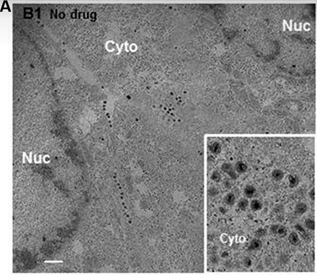NU 2019-084
INVENTORS
Jonathan Leis*
Chi-Hao Luan
SHORT DESCRIPTION
Antiviral agents targeting a broad range of enveloped viruses for pan-viral therapeutics
BACKGROUND
To date, there are very few shared mechanisms identified between families of shared viruses. As such, there is minimal development of a broad-spectrum antiviral. Enveloped viruses bud from host cell membranes, and require the recruitment of host cell proteins in order to spread infectivity. Budding complexes facilitate the spread of virus to uninfected cells. As such, an antiviral that focuses on this mechanism has the potential to treat a wide array of enveloped viruses.
ABSTRACT
In this novel therapeutic target, NU scientists identified the ESCRT machinery as essential to infectivity in a multitude of viral families. Specifically, ESCRT proteins are recruited to virus budding complexes, increasing infectivity and the necessary time for regulation by the immune system. Viral particles must be able to translocate through cellular membranes, and ESCRT proteins have been shown to be necessary for this process in a variety of viral families, including both HIV and Herpes Simplex Virus (HSV). As such, this technology targets ESCRT proteins as an expansive, broad range therapeutic pathway for viral infections. Specifically, the inventors have identified Tsg101 as a targetable protein in the ESCRT complex. As a proof of concept, established drugs shown to bind Tsg101 were effective in preventing the release of viral particles. Binding of Tsg101 was able to trap viral particles in the nucleus and prevent release to the cytosol, where virus could ultimately bud and be released. The ESCRT complex is implicated in viral infectivity of at least 8 different families. Furthermore, targeting budding is a novelintervention which acts early in the viral life cycle. As such, these treatments will act earlier to halt the spread of infection and increasing the effectiveness of an immune response. Additional manufacture of drugs specifically designed to target ESCRT proteins could introduce a range of widely effective and applicable antiviral therapies.
APPLICATIONS
• Treatment of lentiviruses (including HIV)
• Treatment of herpes virus
• Treatment of other families of virus operating using similar machinery
ADVANTAGES
• Broad treatment has efficacy in multiple virus families
• Allows larger production for application to many viral infections
• Prevents viral budding, reducing internal spread of infection and permitting a more efficient immune response
PUBLICATION
Leis J, Luan CH, Audia JE, Dunne SF, Heath CM. (2021). Ilaprazole and Other Novel Prazole-Based Compounds That Bind Tsg101 Inhibit Viral Budding of Herpes Simplex Virus 1 and 2 and Human Immunodeficiency Virus from Cells. J Virol, 95(11). https://doi.org/10.1128/JVI.00190-21
IP STATUS
US patent has been filed.


A. Shows viral replication of HSV-2 in cells without treatment. B. Administration of tenatoprazole, an ESCRT-targeting drug, prevents viral translocation to the cytosol, inhibiting the ability of viral particles to spread to uninfected cells.